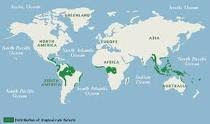
This map shows the areas of the Tropical Rainforest, it is located right at the equator. This biome has a wet climate where on average there is 1500 and 2500 mm in rain which fall year round. There is no dry season, it rains almost everyday. 30 degress- 35 degrees during the day and drops about 10 degrees at night.


































